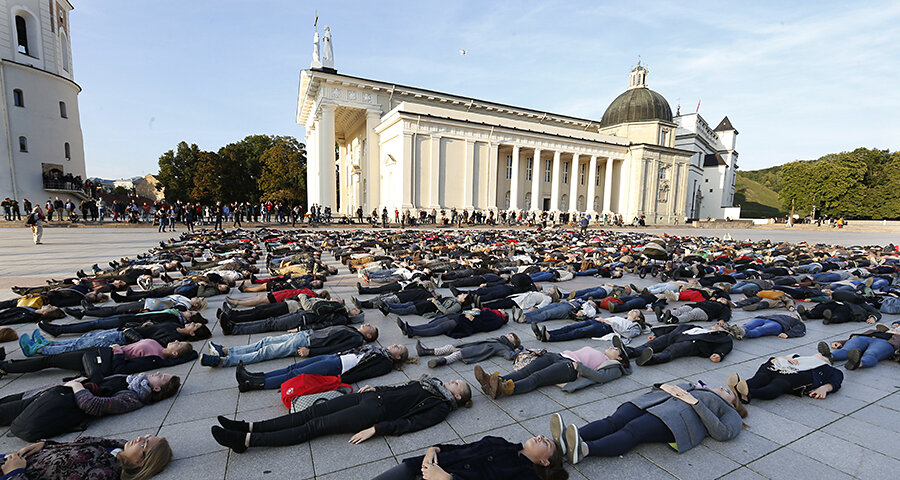Lithuania looks to shed unwelcome distinction: suicide capital of Europe
Loading...
| Vilnius, Lithuania
Modern Lithuania has a number of distinctions of which its 3 million people are proud.
It was the first of the former Soviet socialist republics to break away, declaring independence in March 1990.
It “grows” basketball players: Lithuania has won medals in both European basketball championships and the Olympics despite its small population.
It boasts a UNESCO-listed world heritage site in Vilnius, with its historic old center and an impressive melange of Gothic, Renaissance, Baroque, and Classical buildings.
But the otherwise upbeat modern narrative has a darker strand – that of Europe’s suicide leader. The most recent available government statistics illustrate the country’s dilemma: in 2013, there were 36 suicides per 100,000 people, and in 2014, there were 31 per 100,000, the fourth-highest rate in the world and the highest in Europe. The next European country to appear on the list, according to the World Health Organization, is Russia, at 14th, with 19.5 suicides per 100,000.
In numerical terms, this means that approximately 1,000 Lithuanians, or about one out of every 2,000 citizens, kill themselves every year.
By contrast, the suicide rate in the two other Baltic republics of Latvia and Estonia, according to the WHO, is considerably lower. Neighboring Latvia has a rate of 16.2, for a ranking of 27, and Estonia has a rate of 13.2, placing it 38th on the list.
“Somehow suicide has become part of the modern Lithuanian story,” says Vaiva Klimaite, a clinical psychologist with the Vilnius municipality and one of a small group of intensely committed Lithuanian "suicidologists" who are studying the situation. And they say that to reduce suicide rates, the government – and Lithuanian society more broadly – will need to directly acknowledge the thorny issue and provide support for those private groups trying to grapple with it.
A particularly Lithuanian issue
To be sure, the country's suicide rate has ebbed and flowed. From 1918 to 1940, during the so-called “golden years” of the first Lithuanian republic, after the nation first disengaged itself from Russia, the rate was a low 8.1 per 100,000.
It rose again starting in 1944, when the country was reoccupied by the Kremlin, reaching a high of 36 per 100,000 in 1984, just as the fissures in the Soviet empire were beginning to show.
Even that high may have been underestimated. “Suicide did not exist during the Soviet time because it did not fit the idea of a nation living happily under socialism,” according to Danute Gailiene, a professor at Vilnius University and author of “Lithuanian faces after the transition,” which delves into the suicide issue and its background. “The word 'suicide' did not even appear in Soviet encyclopedias.”
The suicide rate continued to climb during the difficult transitional years after 1990, hitting highs of 45.6 per 100,000 in 1995 and 44.1 in 2000. Since then it has declined, but not nearly enough to challenge the country's unwanted status as Europe’s suicide leader.
By contrast, the suicide rates of neighboring Estonia and Latvia have gone down. “Estonia and Latvia have coped with this better because both the government and society acknowledged it and developed a suicide prevention strategy,” says Dr. Klimaite, who also works as a private psychologist. “We didn’t, and to a great degree still don’t.”
The Lithuanian attitude to suicide may also be reflective of the Roman Catholic Church's view that suicide is a sin: unlike Estonia and Latvia, Lithuania is overwhelmingly Catholic.
“Suicide is still taboo here,” says Said Dadasev, a postgraduate student in organizational and clinical psychology at Vilnius University. “People think that that if they have thoughts of suicide that they are deficient in some way and are afraid of the reactions of other people. Consequently they don’t seek the help they need.”
'Telling a different story'
Mr. Dadasev believes that the government is still in denial about the problem. “The fact that our country still does not have a national suicide prevention program shows that there is still much work to do.”
Antanas Grizas, a founder of Youthline, a psychological outreach program for young Lithuanians, also thinks that the government could do more.
“I think the problem is not so much of resources,” says Mr. Grizas, who volunteers at the Vilnius center, “but one of strategy and priorities.” He believes that the focus on medicalization and hospitalization is a carryover from the Soviet era.
“In Lithuanian politics and mental health professional circles, the biomedical approach to mental health problems still dominates,” Mr. Grizas asserts. “Some even say – and I agree with them – that mental health care hasn’t really changed since Soviet times. We lack community-based approaches, social integration, as well as accessibility to psychological treatment.”
Lithuania needs “a radical reform of its mental health program,” says Paulius Skruibis, who helped found Youthline in 1996. “We need a well-funded long-term suicide prevention program.”
While the government debates the issue, voluntary agencies and organizations like Youthline are struggling to fill the breach. Another such organization is Café Mano Guru, a sprawling cafe-restaurant in Vilnius Old Town that sponsors an integration program for at-risk people, to provide those suffering from drug and other psychological problems with apprenticeships in the culinary arts.
“The ghost of the Soviet time is still too much with us,” says Sima Vaskelyte, the project manager. “People who need help are still too afraid to reach out. And when they do, the kind of help they need is not there. We are doing our best, but we are still losing too many people, especially in the small villages.”
Or, as Klimaite puts it, “I believe we have to start telling a different story about ourselves. Until we do, Lithuania will remain a society at risk.”







